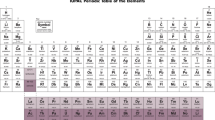Abstract
It is proposed that molecular phenomena may only be described within the framework of the Complementarity Principle (‘CP’), and that scientific controversy may originate in the essential incompatibility of complementary representations. Complementarity based on the temporal Uncertainty Principle leads to new insights into transition state theory, microscopic reversibility and the Curtin-Hammett Principle. An empirical application of the ‘CP’ to the structural theory leads to a revision of present concepts of ‘reaction dynamics’, with the Principle of Least Nuclear Motion (‘PLNM’) emerging as a general alternative to electronic theories of reactivity. In fact, it is argued that the ‘PLNM’ is a better basis for the Woodward-Hoffmann rules than is orbital symmetry. A more flexible approach to organic reaction mechanisms is thus indicated. Also, as the basis of the structural theory is fundamentally uncertain, and the present theory of X-ray diffraction apparently incompatible with the ‘UP’, a reinterpretation of the Bragg equation has been attempted.
Similar content being viewed by others
References
H. Primas, Chimia 36, 293 (1982).
P.W. Atkins, Molecular Quantum Mechanics, 2nd Ed., Oxford University Press, Oxford, 1983, pp. 18 and 92.
J. Mehra, The Quantum Principle: Its Interpretation and Epistemology, D. Reidel Publishing Company, Dordrecht/Boston, 1974.
S. Chandrasekhar, Res. Chem. Intermed. 23, 55 (1997).
S. Chandrasekhar, Res. Chem. Intermed. 23, 137 (1996).
K.J. Laidler, Theories of Chemical Reaction Rates, McGraw-Hill, New York, 1969.
L.P. Hammett, Physical Organic Chemistry, 2nd Ed., McGraw-Hill, New York, 1970.
M.L. Sinnott Adv. Phys. Org. Chem. 24, 113 (1988).
S. Chandrasekhar, Res. Chem. Intermed. 17, 173 (1992).
F.R. Jensen and B. Rickborn, Electrophilic Substitution of Organo-mercurials, McGraw-Hill, New York, 1968, p. 157; D.S. Matteson, Organometallic Reaction Mechanisms, Academic Press, New York, 1974, pp. 94 and 96; Idem. Organometal. Chem. Rev. 4, 263 (1969).
J.I. Seeman, Chem. Rev. 83, 83 (1983).
R.G. Woolley, J. Am. Chem. Soc. 100, 1073 (1978); Idem., New Sci. 120, 53 (1988); Idem., J. Chem. Educ. 62, 1082 (1985); Idem., Struct. Bonding (Berlin) 52, 1 (1982); S.J. Weininger, J. Chem. Educ. 61, 939 (1984).
A.J. Rocke, Chem. Br. 29, 401 (1993); R.W. Rosner, ibid. 29, 675 (1993).
P.W. Atkins, Physical Chemistry, 5th Ed., Oxford University Press, Oxford, 1995; (a) chapter 11–14, (b) p. 412.
H.C. Brown, The Nonclassical Ion Problem, Plenum, New York, 1977.
C.L. Perrin and J.D. Thoburn, J. Am. Chem. Soc. 115, 3140 (1993).
F.M. Menger, Acc. Chem. Res. 26, 206 (1993).
D.R. Storm and D.E. Koshland Jr., J. Am. Chem. Soc. 94, 5805 (1972); A.D. Mesecar, B.L. Stoddard and D.E. Koshland Jr., Science 277, 202 (1997).
J. Hine, Adv. Phys. Org. Chem. 15, 1 (1977).
R.B. Woodward and R. Hoffmann, Conservation of Orbital Symmetry, Verlag Chemie, Weinheim, 1970; I. Fleming, Frontier Orbitals and Organic Chemical Reactions, Wiley, London, 1976.
E.N. Marvell, Thermal Electrocyclic Reactions, Academic Press, New York, 1980.
E.L. Eliel, S.H. Wilen and L.N. Mander, Stereochemistry of Organic Compounds, Wiley, New York, 1994; (a) p. 621, (b) p. 755.
N.J. Turro, Modern Molecular Photochemistry, Benjamin/Cummings, Menlo Park (CA), 1978; (a) p. 11, (b) p. 424.
W.J. Buma, B.E. Kohler and K. Song, J. Chem. Phys. 94, 6367 (1991).
J.P. Glusker and K.N. Trueblood, Crystal Structure Analysis, 2nd Ed., Oxford University Press, New York and Oxford, 1985.
Author information
Authors and Affiliations
Rights and permissions
About this article
Cite this article
Chandrasekhar, S. Controversy and complementarity in mechanistic organic chemistry. The transition state and structural theories reexamined. Res. on Chem. Intermed. 24, 625–642 (1998). https://doi.org/10.1163/156856798X00528
Received:
Accepted:
Issue Date:
DOI: https://doi.org/10.1163/156856798X00528




